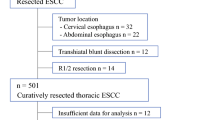Abstract
Background
Post-surgical solitary lymph node recurrence (SLNR) may be a characteristic of esophageal squamous cell carcinoma (ESCC).
Methods
Among 402 patients who underwent curative resection for ESCC between 2003 and 2010, we retrospectively reviewed the cases of 148 patients who developed disease recurrence.
Results
Among the 148 reviewed cases, 24 patients (16.2 %) developed SLNR and 124 (83.8 %) developed non-SLNR. Clinicopathological background did not differ between the two groups. Five-year overall survival was 37.8 % among the 22 patients with SLNR who received local treatment (surgery or radiation) with or without systemic chemotherapy, compared with only 2.5 % among patients with non-SLNR (p = 0.0002). Among the 24 cases of SLNR, 18 were localized inside the surgical field (i.e. the standard three-field regional lymph nodes), while six occurred outside of the surgical field (abdominal para-aortic nodes in four cases and mediastinum in two cases). Notably, of the six patients with SLNR outside of the surgical field, four survived without additional recurrence after SLNR development. Among patients with SLNR, survival was not associated with tumor location, tumor size, or time to recurrence. Initial tumor stage was not associated with SLNR incidence but was identified as a predictor of long-term survival among patients with SLNR.
Conclusions
SLNR developed inside and outside of the surgical field, showing a relatively favorable prognosis with local treatment regardless of location. SLNR outside of the surgical field may actually be localized disease in ESCC.


Similar content being viewed by others
References
Dresner SM, Griffin SM. Pattern of recurrence following radical oesophagectomy with two-field lymphadenectomy. Br J Surg. 2000;87:1426–33.
Nakagawa S, Kanda T, Kosugi S, et al. Recurrence pattern of squamous cell carcinoma of the thoracic esophagus after extended radical esophagectomy with three-field lymphadenectomy. J Am Coll Surg. 2004;198:205–11
Hulscher JB, van Sandick JW, Tijssen JG, et al. The recurrence pattern of esophageal carcinoma after transhiatal resection. J Am Coll Surg. 2000;191:143–8
Miyata H, Yamasaki M, Kurokawa Y, et al. Survival factors in patients with recurrence after curative resection of esophageal squamous cell carcinomas. Ann Surg Oncol. 2011;18:3353–61
Blom RL, Lagarde SM, van Oudenaarde K, et al. Survival after recurrent esophageal carcinoma has not improved over the past 18 years. Ann Surg Oncol. 2013;20:2693–8
Nakamura T, Ota M, Narumiya K, et al. Multimodal treatment for lymph node recurrence of esophageal carcinoma after curative resection. Ann Surg Oncol. 2008;15:2451–7
Baba M, Natsugoe S, Kusano C, et al. Lymph node metastasis and the recurrence of esophageal carcinoma with emphasis on lymphadenectomy in the neck and superior mediastinum. Surg Today. 1995;25:125–30
Jingu K, Ariga H, Nemoto K, et al. Long-term results of radiochemotherapy for solitary lymph node metastasis after curative resection of esophageal cancer. Int J Radiat Oncol Biol Phys. 2012;83:172–7
Kaisaki S, Kitayama J, Ishigami H, et al. Solitary nodal recurrence in the dorsal area of the thoracic aorta after a curative resection of esophageal cancer: report of two cases. Surg Today. 2007;37:243–7
Sobin L GM, Wittekind C. TNM classification of malignant tumours. 7th ed. New York: Wiley; 2009
Miyata H, Yamasaki M, Takiguchi S, et al. Prognostic value of endoscopic biopsy findings after induction chemoradiotherapy with and without surgery for esophageal cancer. Ann Surg. 2011;253:279–84
Makino T, Doki Y, Miyata H, et al. Use of (18)F-fluorodeoxyglucose-positron emission tomography to evaluate responses to neo-adjuvant chemotherapy for primary tumor and lymph node metastasis in esophageal squamous cell carcinoma. Surgery. 2008;144:793–802
Miyata H, Yamasaki M, Takahashi T, et al. Relevance of [18F]fluorodeoxyglucose positron emission tomography-positive lymph nodes after neoadjuvant chemotherapy for squamous cell oesophageal cancer. Br J Surg. 2013;100:1490–7
Miyata H, Yano M, Doki Y, et al. A prospective trial for avoiding cervical lymph node dissection for thoracic esophageal cancers, based on intra-operative genetic diagnosis of micrometastasis in recurrent laryngeal nerve chain nodes. J Surg Oncol. 2006;93:477–84
Akiyama H, Tsurumaru M, Udagawa H, et al. Radical lymph node dissection for cancer of the thoracic esophagus. Ann Surg. 1994;220:364–72; discussion 372–3
Shimada H, Kitabayashi H, Nabeya Y, et al. Treatment response and prognosis of patients after recurrence of esophageal cancer. Surgery. 2003;133:24–31
Yano M, Takachi K, Doki Y, et al. Prognosis of patients who develop cervical lymph node recurrence following curative resection for thoracic esophageal cancer. Dis Esophagus. 2006;19:73–7
Ando N, Kato H, Igaki H, et al. A randomized trial comparing postoperative adjuvant chemotherapy with cisplatin and 5-fluorouracil versus preoperative chemotherapy for localized advanced squamous cell carcinoma of the thoracic esophagus (JCOG9907). Ann Surg Oncol. 2012;19:68–74
Conflict of interest
Tomoki Makino, Makoto Yamasaki, Hiroshi Miyata, Koji Tanaka, Tsuyoshi Takahashi, Yukinori Kurokawa, Kiyokazu Nakajima, Shuji Takiguchi, Masaki Mori, Yuichiro Doki have no conflicts of interest that are directly relevant to the content of this study.
Author information
Authors and Affiliations
Corresponding author
Electronic supplementary material
Below is the link to the electronic supplementary material.
10434_2015_5086_MOESM1_ESM.docx
Supplemental Fig. 1 Recurrence pattern categorization. Our final analysis included 24 patients with SLNR and 124 patients with non-SLNR, including recurrence types other than LN, multiple LN recurrence, and distant recurrence. SLNR solitary lymph node recurrence, LN lymph node (DOCX 33 kb)
Rights and permissions
About this article
Cite this article
Makino, T., Yamasaki, M., Miyata, H. et al. Solitary Lymph Node Recurrence of Esophageal Squamous Cell Carcinoma: Surgical Failure or Systemic Disease?. Ann Surg Oncol 23, 2087–2093 (2016). https://doi.org/10.1245/s10434-015-5086-y
Received:
Published:
Issue Date:
DOI: https://doi.org/10.1245/s10434-015-5086-y




